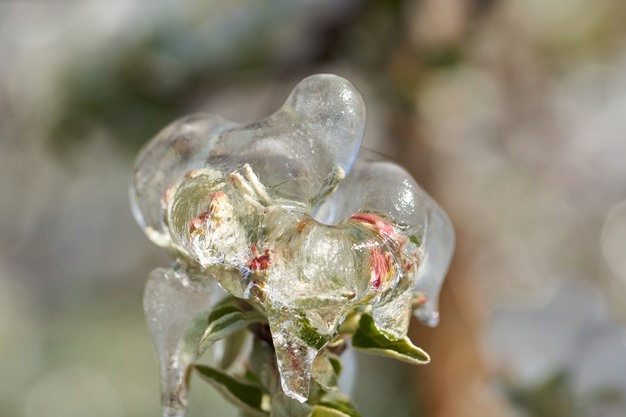From Sunday to Monday to Tuesday, fruit growers in Flanders and the Netherlands held their breath momentarily. Due to the freezing cold, alarm clocks had to be set very early to ensure everything ran smoothly. The temperatures weren't extreme, but they were still low enough to warrant close monitoring. "Still, it was nothing spectacular in Belgium and the Netherlands, mind you," said Tony Derwael of Bel'Export. "People had to stay alert, but fire pots proved effective, and we used wind machines, which helped us gain a few degrees."
 © Patrice88 | DreamstimeAs is the tradition, images of fire pots surface as soon as the first signs of spring frost appear. "Every year, there are a few nights when temperatures drop to freezing," said Gunter Roes of Appelen Roes in an interview with VRT. "This time, it was only a light frost, but we have to stay vigilant. If it drops to -3 or -4°C, then it's all hands on deck. Things can change very quickly. That's why we monitor all available weather forecasts closely. Sometimes, temperatures unexpectedly fall below zero. We also have temperature alarms in the orchard. So we need to stay wide awake and react immediately." At his farm in Oud-Turnhout, the cherries are currently in bloom. "We've covered the older trees with a type of foil, which gives us a few extra degrees of protection. It also shields against rain and birds. The young trees aren't covered yet. We placed fire pots between them." And successfully so, as there appears to be virtually no damage.
© Patrice88 | DreamstimeAs is the tradition, images of fire pots surface as soon as the first signs of spring frost appear. "Every year, there are a few nights when temperatures drop to freezing," said Gunter Roes of Appelen Roes in an interview with VRT. "This time, it was only a light frost, but we have to stay vigilant. If it drops to -3 or -4°C, then it's all hands on deck. Things can change very quickly. That's why we monitor all available weather forecasts closely. Sometimes, temperatures unexpectedly fall below zero. We also have temperature alarms in the orchard. So we need to stay wide awake and react immediately." At his farm in Oud-Turnhout, the cherries are currently in bloom. "We've covered the older trees with a type of foil, which gives us a few extra degrees of protection. It also shields against rain and birds. The young trees aren't covered yet. We placed fire pots between them." And successfully so, as there appears to be virtually no damage.
For apples and pears, in addition to wind machines like those used by the Derwael family, growers often use irrigation. This is also the case at Bijl's Fruit, where Wim Bijl explained, "We irrigated from Sunday to Monday when the temperature dropped to -1.6°C." At the Fruit Research Centre (FRC) in Randwijk, apple blossoms were protected these nights using a new water-saving misting technique, according to AD. Instead of the usual sprinkling method, a fine spray was used, which reduced water consumption by 30 percent. The technique forms a layer of ice around the blossom, preventing it from freezing. Although the system is more expensive than traditional sprinkling and is not yet suitable for widespread commercial use, it shows promise for the future, particularly in terms of water conservation. The blossoms in the trial orchard survived the frost without damage.
Frost already seems to be over
This seems to be the case particularly in Belgium and the Netherlands, Tony notes. "We had to be careful for a few nights, but by yesterday, the frost was over, and now we're heading toward temperatures of 20 to 25°C in the coming days. That means top fruit can also develop quickly. So it's possible we won't have a late season after all, as initially thought. We might have a normal year. People often say that pears need to stay on the tree for 130 days from flowering, which would have us harvesting in early September. That would be a normal time, compared to mid-August last year, which was very early."
As for the current season, the trader is also satisfied. "This season appears to be ending very well for pears. Prices have risen nicely in recent months, and we don't expect major issues with the remaining stocks. The same applies to apples, where prices have only improved as we approach the end of the season. Demand remains strong, so I expect a positive conclusion to the final months." The trader even expresses confidence in the upcoming season. "The trees are in good condition. The buds are strong, so if we're spared frost damage, I foresee a superb harvest—one where we may even struggle to pack everything. Still, there's a month left where frost could hit, so we always need to speak conditionally."
Major frost damage in Eastern Europe
While Belgium and the Netherlands have little to worry about, Tony sees more challenges in Eastern Europe. "There, people are reporting significant frost damage to early stone fruit—plums, cherries, apricots—especially the early varieties. In countries like Moldova and the surrounding region, there are reports of 50 to 80 percent frost damage. This could cause some issues there. We shouldn't exaggerate, but let's be honest—there is some concern about frost damage. This mainly applies to early crops, as apples and pears are still at an earlier stage of development in those regions, so there's little to say about them just yet."
For more information:
Tony Derwael
Bel'Export![]()
Neremstraat 2
3840 Borgloon - Belgium
Tel +32 12 440 551
belexport@belexport.com
www.belexport.com
